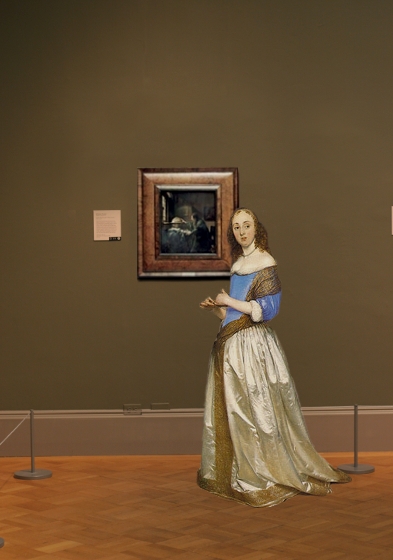The Astronomer
(De astronoom)1668
Oil on canvas
50 x 45 cm. (19 5/8 x 17 3/4 in.)
Musée du Louvre, Paris
inv. RF 1983–1928

The textual material contained in the Essential Vermeer Interactive Catalogue would fill a hefty-sized book, and is enhanced by more than 1,000 corollary images. In order to use the catalogue most advantageously:
1. Scroll your mouse over the painting to a point of particular interest. Relative information and images will slide into the box located to the right of the painting. To fix and scroll the slide-in information, single click on area of interest. To release the slide-in information, single-click the "dismiss" buttton and continue exploring.
2. To access Special Topics and Fact Sheet information and accessory images, single-click any list item. To release slide-in information, click on any list item and continue exploring.
The window
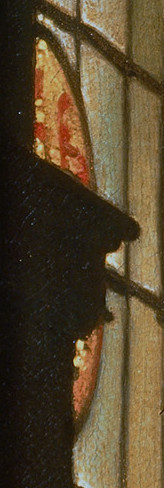
The structure of the window in Vermeer's Astronomer mirrors that of The Geographer, featuring a decorative stem with color, absent in the latter. Vermeer might have included it purely for aesthetic reasons or due to its potential symbolic significance, either for himself or the potential commissioner of the paintings.
The astronomer's room receives significantly less light compared to the geographer's due to the closed second casement of the window, situated between the open casement and the furniture behind it. Consequently, the incoming light becomes focused on the contemplative scholar and the celestial globe, creating an aura of mystery in harmony with the study of the cosmos.

A Girl in a Window with a Bunch of Grapes
Attributed to Gerrit Dou
1662
Oil on panel, 38 x 29 cm.
Galleria Sabauda, Turin
Hans Slager, a Dutch archivist, has noted that, so far, the eight windows in Vermeer's work that feature the same central, quatrelobed geometric design as in the present work, only three have been identified in the works of other artists. One is by Gerrit Dou (1613-1675), titled Girl at Window with a Bunch of Grapes, dated 1660, and is housed in the Royal Collection Trust, UK. Another nearly identical piece by Dou from 1662 is in a private collection belonging to Prinz Eugen von Savoyen in Vienna/Turin. There's also one by Pieter Cornelisz Slingelandt (1640-1691), titled Lacemaker Buying a Cock Through the Window, located in Gemäldegalerie Alte Meister, Dresden, from 1672.
In the 17th century, glass windows in Dutch houses underwent significant developments.. Crown glass, a type of hand-blown glass, was commonly used during this period. These improvements allowed for larger windows, which not only provided more light but also contributed to the aesthetics of buildings. The design of glass windows included glazing bars or mullions, which divided larger windows into smaller panes. These bars not only added structure but also facilitated the production and replacement of individual glass panes if needed. While glass provided light, it also presented challenges in terms of privacy. To address this, curtains or shutters were often used to cover windows, allowing occupants to control the amount of light and visibility. Stained glass was another decorative element used in some houses, often featuring intricate patterns or heraldic motifs.
Different types of windows were used for various purposes. Casement windows, like the one we see in Vermeer's Astronomer, which opened outward on hinges, were common for residential buildings. Sliding sash windows, where the panes move vertically, also gained popularity during this time.
The painting on the background wall representing the Finding of Moses
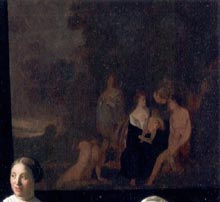
The selection of the specific picture-within-a-picture, depicting Moses in the bullrushes, was intentional and not by chance. In the Acts of the Apostles, Moses is described as being "learned in all the wisdom of Egypt," a wisdom that likely encompassed astronomy, a field in which the Egyptians excelled. Moses was also regarded as the "oldest geographer," leading the Hebrews during their exile. He was considered the patron saint of a type of science that didn't rely on observation and experimentation like modern science, but rather on tapping into the ancient sources of wisdom from civilizations past.
Moses held a unique significance for the Dutch, who saw the United Provinces as a parallel to the new Israel, the Promised Land. Therefore, the inclusion of the Moses painting in Vermeer's Astronomer encapsulates two distinct forms of 17th-century science: the modern and the ancient.
Interestingly, the same painting appears as a prop in Vermeer's later work, Lady Writing a Letter with her Maid. In this painting, the depiction of Moses is noticeably larger than in The Astronomer and, according to art historians, carries a different symbolic meaning altogether.
The technical chart
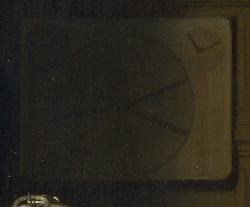
James E. Welu, a specialist in 17th-century Dutch and Flemish painting and cartography, has suggested that hanging on the cupboard at roughly the same level as the picture-within-a-picture is a celestial planisphere, most likely drawn from a copy of the Coelestum Planum, which was published in Rotterdam in 1619 by Jan Janz Stampioen the Elder. By the time Vermeer had painted the present work, it had been revised and reprinted several times, by, among others, the Amsterdam publisher Hendrick Doncker.
The celestial planisphere, often just referred to as a planisphere, is a star chart analog computing instrument in the form of two adjustable disks that rotate on a common pivot. It can be adjusted to display the visible stars for any time and date.
It is comprised of two components: Star Plate and Oval Overlay. The Star Plate is the circular star map that has stars and constellations drawn on it. It often covers a broad range of latitudes, so users in different regions can still find it useful. The Oval Overlay represents the observer's horizon and can be rotated over the star plate to show which stars are visible at a particular time and date. By adjusting the planisphere to align the date and time, the star plate shows the constellations that would be visible from the ground at that specific time and date.
The books on the cupboard
Regrettably, the topics or titles of the twenty-five books "of all kinds" mentioned in the inventory of Vermeer's estate remain unknown. Nonetheless, given the costliness of books during that era, this count is noteworthy for a family of moderate economic status.
Dutch art expert Walter Liedtke posits that "the illusions made in several of his pictures suggest that he was not unread, at least in fields directly related to the matters at hand. And Vermeer probably had a few well-schooled acquaintances, in particular Constantijn Huygens (who corresponded with Descartes and Mersenne). But there seems no reason to rank Vermeer with learned artists like Rubens or Poussin; he probably had some second-hand notions of science and philosophy, but they appear to have had little bearing on his style. The very qualities that comprise Vermeer's so-called classicism—a term which has nothing to do with other aspects of his work—had been favored in Delft and The Hague for decades: perspective, proportion, restrained action and expression, a sense of order and in some cases, measure and harmony."
During the 17th century in the Netherlands, books were highly valued and held a significant place in society. However, they were also relatively expensive and considered a luxury item. The cost and rarity of books were influenced by various factors, including production methods, materials and the demand for specific types of literature. Thus books were limited to a relatively small portion of the population, primarily the educated elite, scholars, professionals and the wealthy merchant class. Book ownership was a status symbol, showcasing one's intellectual and social standing. As a result, the majority of the population had limited access to books due to their high cost. To afford books, individuals often had to invest a significant portion of their income. Bookstores, printers and publishers were established in major cities like Amsterdam, Leiden and Utrecht, catering to the demand for various types of literature. Public libraries also existed in some cities, providing access to books for those who couldn't afford to buy them.
The most popular books during the 17th century in the Netherlands covered a wide range of subjects, reflecting the intellectual curiosity and cultural diversity of the time. Some of the notable categories of popular books included: religious texts, scientific and philosophical works. The Dutch Golden Age was a period of significant advancement in science and philosophy. Works by philosophers like René Descartes and scientific treatises on topics like astronomy and medicine gained popularity.
The Dutch were also known for their exploration and trade activities. Travel accounts and narratives describing faraway lands and exotic cultures were widely read. the Netherlands was a republic with a strong tradition of civic engagement and economic entrepreneurship. Political treatises and works on economics were sought after by those interested in governance and commerce. In addition, Dutch literature flourished during this period, with playwrights, poets and novelists producing works in both Dutch and Latin. The plays of Joost van den Vondel and the poetry of Constantijn Huygens are examples of popular literary works.
The open book on the table
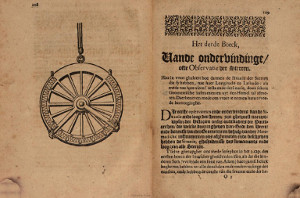
While the open book's printed content has been rendered using just a few skillful brushstrokes, their precise placement enabled historian James A. Welu to pinpoint the volume as the 1621 second edition of a work by Adriaan Metius titled Institutiones Astronomicae et Geographicae. This open book reveals Book III, advocating "inspiration from God" for astronomical exploration, coupled with geometry knowledge and the assistance of mechanical tools.
On the right-hand page, text fills the space, while the left-hand page depicts a "cartwheel astrolabe," an invention by Metius used for calculating sun and star positions. Metius' book served as a practical guide for studying astronomy and geography, fields more intertwined in the 17th century than today. The book targeted "shippers and pilots," providing "concise and clear instructions for the art of navigation." Notably, Metius had apprenticed under the renowned Danish astronomer Tycho Brahe.
The celestial globe
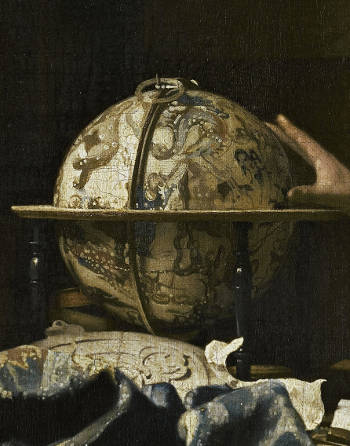
With his fingers spread wide, the astronomer adjusts the globe to its required position. As the Vermeer expert Gregor Weber pointed out, the painter orchestrates this gesture as a pivotal moment of profound realization for the scientist. Deliberately positioned along the central horizontal axis extending from the windowsill to the globe's supporting bracket and the outstretched arm, this action forms a crucial juncture in the painting. Aligning with the vanishing point of the composition, the motion of the astronomer's hand captures his quest, with his gaze following suit. In addition, Vermeer emphasizes the notion of "grasping" the world, symbolized by the space between his forehead and left hand, illuminated by a horizontal strip of light. Originating from the window, this light traverses the scientist's instruments, his hands and eventually his face, symbolizing the transition from the physical to the intellectual realm of perception.
The author of the opened astronomical manual on the table recommended using the globes of Willem Janz. Blaeu. However, Vermeer chose to paint one made by Blaeu's main rival, Jodocus Hondius. Hondius' globe features intricate constellation patterns, some of which can be discerned in the artist's exquisite depiction.
In the upper left section, the Great Bear is depicted, while the center features the Dragon and Hercules and the right side shows Lyra. Three surviving copies of this celestial globe can be found in the following collections: the Huntington Library in San Marino, the Giannini Library in Lucca and the Nederlands Scheepvaartmuseum in Amsterdam. Typically, celestial globes were sold in pairs with terrestrial globes. Notably, Vermeer portrayed the same globe in The Geographer and his later work, Allegory of Faith.
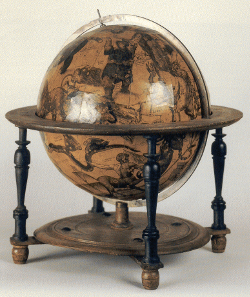
Globes of this period were always produced and sold in pairs, a practice that demonstrates the close relationship between astronomy and geography at the time.
The astrolabe
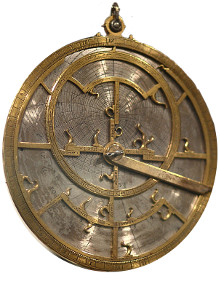
Astrolabe made by Jean Fusoris, Paris (1400)
The maker of the astrolabe, propped up obliquely against the globe, has recently been identified by Koenraad Van Cleempoel as Willem Jansz. Blaeu, who was also the author of the map in Vermeer's The Geographer.
The astrolabe is a historical astronomical instrument and analog computer used by classical astronomers and astrologers. It had numerous functions, including locating and predicting the positions of celestial bodies, determining local time based on longitude, surveying and triangulation. This identification was made through detailed engravings of astrolabes by Blaeu, dedicated to Metius and published in Metius' 1632 book, Astrolabium.
While the true inventor of the astrolabe remains uncertain, it was a primary navigational tool until the 18th-century invention of the sextant. Some attribute its invention to Hipparchus (2nd century B.C.), while others credit Hypatia of Alexandria. Astrolabes held significance not only for practical maritime navigation among the Dutch but were also found in the collections of the wealthy elite known as "cabinets of curiosities."
In Vermeer's The Astronomer, the presence of the astrolabe may symbolize humanity's need to navigate life's journey using logic and precise measurement.
Who posed for the scientist?
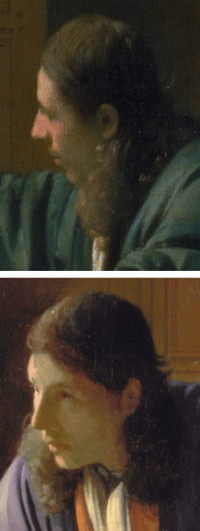
None of the models who posed for Vermeer's interiors have ever been identified, even though many scholars have supposed that the majority were members of his own family, especially his wife and eldest daughters.
Specialists have always entertained the idea that the same man, with a straight nose and full lips, posed for both The Astronomer and The Geographer (details left). He also bears a certain resemblance to the standing suitor in The Music Lesson. It seems out of the question that Vermeer himself posed for The Astronomer, even though a now-lost self-portrait is documented in a 1696 auction.
The most likely candidate for the scientist, although far from certain, was Antonie van Leeuwenhoek, the famous Dutch scientist who lived a few blocks from Vermeer in Delft. Van Leeuwenhoek has been linked to Vermeer on two accounts. The Delft scientist was an expert lens maker and could have conceivably helped Vermeer with the lens and optical science necessary to build a camera obscura. Moreover, among the few documents that reveal Vermeer's life is a note from the Delft public records, which states that the aldermen of the city designated Van Leeuwenhoek as the receiver in the bankruptcy case of Catharina Bolnes, Vermeer's widow. It is dated September 30, 1676, a year after the artist's death. Ironically, both men's names appear on another page in the Delft ledger: the one recording their baptisms in 1632.
The scientist's robe
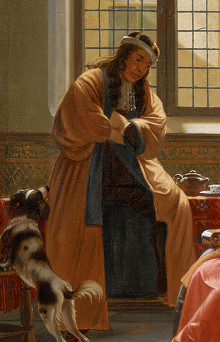
The Reading Lesson (detail)
Cornelis de Man
1653
Oil on canvas, 74.3 x 65.7 cm.
Hoogsteder & Hoogsteder, The Hague
The geographer's contemplative pose is accentuated by an imported Japanese robe, which was a fashion trend in the Netherlands during the mid-17th century. A comparable robe is depicted in Jan Verkolje's portrait of Antonie van Leeuwenhoek, a renowned Delft scientist. Both Van Leeuwenhoek and Vermeer shared a mutual fascination for optics.
This padded kimono-style garment was made according to Western tastes, which required larger proportions and favored a purely decorative arrangement of patterning. The blue silk—which includes Japanese parsley motifs and curious fake family crests—was woven, dyed, and stitched together in Japan before being shipped to a Western market. Few robes were intended for export, highlighting their preciousness. Compared to robes made for the domestic Japanese market, export robes are typically floor length, have wide sleeves, and are heavily padded, among other modifications. Many preserved export garments are made from colorful fabrics with eye-catching patterns, suggesting that European consumers preferred more conspicuous styles.
These robes, known as keizersrokken in Dutch, or Imperial kimonos, were esteemed gifts, typically bestowed in groups of thirty or more, to Dutch merchants privileged enough to visit the Imperial court in Edo, now Tokyo. Such visits were the only instances when these merchants could set foot on the Japanese mainland, as they were otherwise restricted to Deshima (also known as Dejima, a man-made island in the bay of Nagasaki, established in the early 17th century to regulate foreign interactions Japan had during its period of self-imposed isolation, known as Sakoku, which lasted for about 250 years from the early 17th to the mid-19th century). Consequently, these kimonos, also termed Japons, Japonsche rocken, Japonse rok or simply rok, weren't trade items in either Japan or Holland.
By the end of the century, the Japonse rok was not only a popular status symbol for wealthy commissioners but also an attribute for images of scholars and a mechanism for artists’ self-fashioning. Their ceremonial nature made them appropriate attire for indoor events and were often donned by scholars, enthusiasts, scientists, gentlemen and even city officials.
Many artists of the era also painted self-portraits wearing these robes. It wasn't until the mid-18th century that they were manufactured en masse in Europe using imported silk from India and China. In the context of Vermeer's painting, the geographer's attire is a distinct and non-commercialized fashion piece. The sharp folds and the vivid contrast between the robe's colors in the geographer's orange-trimmed rok engage the viewer's eye, subtly indicating the intensity of his intellectual pursuit. The dramatic representation of drapery in Vermeer's work became even more pronounced in his subsequent artworks.
By the end of the 17th century, the rok had grown so popular that regulations were established to prevent them from being worn in churches.
By the mid-17th century, roks were made from imported Indian and Chinese silk and became a more common imitation ware. In Vermeer's day, then, for his astronomer to wear a roks is to wear a garment which had not yet been commodified.
The floral-motif tapestry on the table

A detail from a tapestry from the
workshop of François Spierincx Spiering
Rather than a Turkish carpet, the luxurious floral motif of this fabric resembles that of a similar prop—most likely a hand-woven tapestry—that seems to appear in The Geographer (The Astronomer's presumed pendant), The Love Letter, the Allegory of Faith and, perhaps, The Lacemaker.
In the present picture, it softens the geometric layout of the composition, eliminates the unnecessary empty space below the tabletop, and, perhaps, alludes to the scientist's inner pondering.
Historians have not yet been able to identify the origins of any of the tapestries that appear in Vermeer's interiors, although they were most likely woven in one of Delft's thriving tapestry businesses.
Delft's flourishing tapestry industry was established by a wave of skilled artisans who had fled from religious wars in the south. In 1592, the municipality of Delft allowed François Spierincx Spiering, a Flemish weaver, to set up his workshop on the premises of St Agnes Convent in Delft free of charge. Spiering became one of the most famous weavers in Europe and collaborated with painters Cornelisz. Vroom and Karel van Mander. His son, Pieter Spiering, evidently inherited his father's love of art. He built up an important art collection and sponsored one of the most successful painters in the Netherlands, Gerrit Dou. Speiring was also the son of the great aunt of Pieter Van Ruijven, Vermeer's patron, together with his wife, Maria de Knuijt. Although no supportive evidence exists, one could easily imagine that the interests of Vermeer, Van Ruijven and Spiering would have intersected at some point. Perhaps Spiering took an interest in Vermeer's work and even furnished him with props from his family's tapestry industry.
Negative shapes
The different patches of background walls in Vermeer's paintings are often perceived not merely as empty leftover space, but as active compositional elements in their own right. In visual artists' jargon, they are termed "negative space." Art historians use the term "negative space" to refer to the space that surrounds the object, while "positive space" pertains to the subject—the flower vase in a painting or the structure of a sculpture. In Gestalt psychology, positive space is associated with the "figure," while the negative shape is linked with the "ground." The Japanese word "ma" is sometimes used for this concept, for example in garden design. Negative spaces must become interesting or artistically relevant shapes to become active compositional elements. Although there is no discussion of the concept of negative space in period literature, most critics agree that Vermeer was keenly aware of its power. The deliberate manipulation of negative space in The Astronomer is as evident as it is functional to the painting's mood of intense intellectual introspection.
Vermeer frequently used the negative spaces of his walls to create so-called "false attachments," an optical phenomenon whereby one part of a foreground object is juxtaposed near a second object in a manner that makes the lines, shapes, or tones of the separate objects appear to join up. This creates spatial ambiguity, making them seem to occupy the same plane. In The Astronomer, there are various examples of false attachments. One of the most evident is the point where the lower corner of the picture-within-a-picture and the profile of the figure's robe almost touch, separating and defining the negative shapes of the empty wall behind them as active participants that intensify the dialogue between the painting's narrative and aesthetic content.
Since birth, our eyes are trained to seek out positive shapes. Negative space is biologically meaningless and transient. Therefore, artists must force themselves not only to look at the shapes of objects, but also at the space that surrounds them.
special topics
- Science, philosophy or astrology?
- The first painting by Vermeer ever to be reproduced
- Astronomy in the 17th century
- An extraordinary composition
- Authentic date & signature?
- Men in Vermeer's painting
- Contemporary inspiration
- Pendant with The Geographer?
- The dutch telescope
- Science in Vermeer's time
- A showcase work for Hitler's art museum
The signature
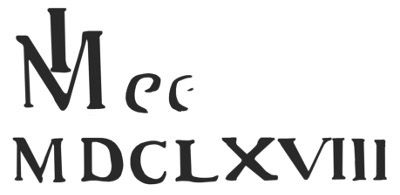
Signed on cabinet: IVMeer / MDCLXVIII [IVM in monogram]
(Click here to access a complete study of Vermeer's signatures.)
Dates
1668
Albert Blankert, Vermeer: 1632–1675, 1975
1668
Arthur K. Wheelock Jr., The Public and the Private in the Age of Vermeer, London, 2000
c. 1668
Walter Liedtke, Vermeer: The Complete Paintings, New York, 2008
1668
Wayne Franits, Vermeer, 2015
c. 1668
Pieter Roelofs & Gregor Weber, VERMEER, Amsterdam, 2023
(Click here to access a complete study of the dates of Vermeer's paintings).
Exhibitions
- (?) Adriaen Paets I, Rotterdam (?1669-d.1686);
- (?) his son, Adriaen Paets II, Rotterdam (1686-d.1712);
- sale (Paets et al.?), Rotterdam, 27 April, 1713, no. 10 or 11, sold together with The Geographer;
- Hendrick Sorgh, Amsterdam (?1713-d.1720);
- Sorgh sale, Amsterdam, 28 March, 1720, no. 3 or 4, sold together with The Geographer;
- Govert Looten, Amsterdam (before d.1727);
- Looten sale, Amsterdam, 31 March, 1729, no. 6, sold together with pendant of the same no. Jacob Crammer Simonsz, Amsterdam (by d.1778);
- Crammer Simonsz sale, Amsterdam, 25 November, 1778, no. 18, sold together with The Geographer as pendant (to De Vries);
- Jean Etienne Fizeaux, Amsterdam (1778-d.1780);
- his widow, Amsterdam (1780-?1785);
- [Pieter Fouquet, Amsterdam, and Alexandre Joseph Paillet, Paris, 1784–1785];
- Jan Danser Nijman, Amsterdam (?before 1794-d.1796);
- Danser Nijman sale, Amsterdam, 16 August, 1797, no. 167, sold separately (to Gildemeester);
- Jan Gildemeester, Amsterdam (1797-d.1799);
- Gildemeester sale, Amsterdam, 11 June, 1800, no. 139 (to La Bouchère);
- Michael Bryan sale, ?London, 9 May, 1804, no. 145a;
- John Gibbons, near Birmingham (by 1820–1828 or later);
- sale, place unknown, 7 October, 1820, no. 31 (bought in);
- his brother?, William Gibbons, sale, London, 18 June, 1857, no. 52, as A Philosopher (to [Henry?] Tate);
- Léopold Double, sale, Paris, 30 May, 1881, no. 17 (to Gauchez);
- [Léon Gauchez, Paris; sold to Rothschild between 1881 and 1888];
- Alphonse de Rothschild, Paris (until d.1905);
- his son, Edouard de Rothschild, Paris (1905-d.1949);
- (between November 1940 and 1945 confiscated for Hitler's intended museum in Linz);
- his son, Guy de Rothschild (1949–1982);
- acquired in 1983 by the Musée du Louvre, Paris (inv. RF 1983–1928).
Exhibitions
- Paris September 24–November 28, 1966
Dans la lumière de Vermeer
Musée de l'Orangerie
no. x and ill. - Paris January 1–March 16
L'Astronome et le Géographe de Vermeer, Napoléon, Exposition Temporaire sous pyramide - Musée du Louvre
- no. 2
- Frankfurt 1997
Johannes Vermeer: der Geograph und der Astronom nach 200 Jahren wieder vereint
Städelschen Kunstinstitut
no. 2 - Atlanta October 12, 2008–September 6, 2009
The Louvre and the Masterpiece
The High Museum of Art - Minneapolis (MN) October 18, 2009–January 19, 2010
The Louvre and the Masterpiece
Institute of Arts - Budapest 31 October, 2014–15 February, 2015
Rembrandt and the Dutch Golden Age
Szépművészeti Múzeum, Budhapest - Tokyo February 21–June 1, 2015
Louvre Museum: Genre Paintings: Scenes from Daily Life
National Art Center - Boston October 11, 2015–January 18, 2016
Class Distinctions: Dutch Painting in the Age of Rembrandt and Vermeer
Museum of Fine Arts - Paris February 22–May 22, 2017
Vermeer and the Masters of Genre Painting: Inspiration and Rivalry
Musée du Louvre - Dublin June 17–September 17, 2017
Vermeer and the Masters of Genre Painting: Inspiration and Rivalry
National Gallery of Ireland - Washington D.C. October 22, 2017–January 21, 2018
Vermeer and the Masters of Genre Painting: Inspiration and Rivalry
National Gallery of Art - Abu Dhabi November 1, 2021–May 30, 2023
(fourth anniversary special exhibition)
Louvre Abu Dhabi
(Click here to access a complete, sortable list of the exhibitions of Vermeer's paintings).
Science, philosophy or astrology?
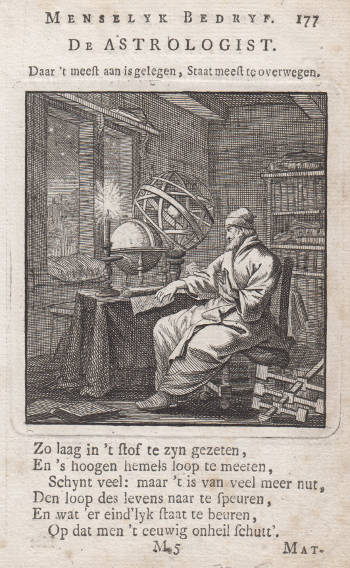
An engraving of an astrologist from:
Spiegel van het menselijk bedrijf
Amsterdam, 1695
Museum Meermanno-Westreenianum
Vermeer's Astronomer should not be interpreted as a depiction of modern science or a painterly expression of the Copernican revolution in astronomy. During Vermeer's time, all natural phenomena, including the heavens, were seen as having moral significance, reflecting the Divine Creator's purpose in every creation. This perspective meant that everything in God's creation carried a moral lesson or admonition.
Historian Klaas van Berkel has shown that this painting combines ancient wisdom (as seen in the painting of Moses on the wall) with modern science, represented by the scientific instruments on the table. It's important to note that the concept of science as a coherent enterprise, as we understand it today, was just beginning to emerge. Science was still competing with deeply ingrained philosophical and religious truths. When undertaken with humility and a genuine quest for understanding, the pursuit of knowledge in the sciences was often intertwined with the desire to comprehend the nature of the divine. While the astronomer's apparent concentration on measurable phenomena—both in the practical realm of astronomy and metaphorically, as he strives to "reach for the stars"—may seem limited to the empirical, it carries a deeper moral message for the observer.
Some scholars in the past have questioned the activity of the figure in the painting, pointing out the absence of a telescope and the fact that the figure works indoors during the daytime. They speculated that he might have been engaged in the older, non-empirical science of astrology—creating horoscopes or attempting to understand the order of the natural world through celestial movements. In that era, there was little distinction between astronomy and astrology, although a clear division existed between astronomy/astrology and physics. Even renowned astronomers like Johannes Kepler and Tycho Brahe, known for their empirical work, were also practicing astrologers. Kepler, for instance, believed in astrology and thought that planetary configurations had tangible effects on humans and earthly events. He believed in establishing a direct relationship between celestial phenomena and earthly occurrences.
Astronomy in the 17th century
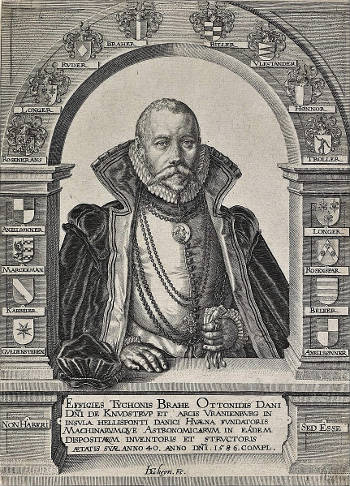
Portrait of Tycho Brahe
Eduard Ender
The abundance of Dutch paintings from the 17th century that depict astronomers and astrologers reflects a keen interest in the study of the universe and its impact on humanity. Vermeer's painting of The Astronomer was created during the construction of Louis XIV's observatory in Paris (1667–1672). In 1668, Isaac Newton made improvements to the design of the reflecting telescope initially developed by James Gregory in 1663. A decade earlier, Christian Huygens had even discovered Saturn's sixth satellite. Astronomy, aside from its intellectual pursuits, played a vital practical role in navigation—a crucial aspect of the Dutch economy, given their maritime trade.
However, amidst the evolving nature of science, the teachings of conservative humanists like Sebastian Brant persisted. They cautioned against delving too deeply into understanding the universe, believing it to be presumptuous and inappropriate in the grand scheme of divine plans. According to their teachings, exploring the nature of stars, the history of the Earth and its size and composition was regarded as improper. They discouraged curiositas, scientific inquiry and any form of empirical research based on experience, even as science was undergoing a revolutionary transformation.
An extraordinary composition

To confer a sense of structure and enduring quality upon his depictions of transient moments, Vermeer meticulously united the visual components within his compositions. In The Astronomer, two distinct facets of the artwork are harmonized—the perspective construction (which produces the illusion of depth) and the painting's flat rectangular surface, referred to as the picture plane. In the adjacent diagram, we observe that the geometric center of the painting (denoted by the intersection of the two yellow diagonals) aligns perfectly with the vanishing point (indicated by the intersection of all the light gray perspective lines). It's worth noting that this alignment isn't coincidental; in fact, the same arrangement was employed in one of Vermeer's earlier pieces, Woman Holding a Balance.
Is the signature authentic?
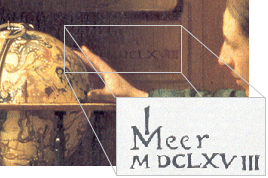
Technical findings published in 1997 have effectively dispelled the lingering skepticism surrounding the authenticity of the signature and date on the cupboard. Consequently, The Astronomer stands among the select few canvases that bear Vermeer's signature and date, affirming his authorship.
Authentic date & signature?
Vermeer is widely recognized for his depiction of women, with male figures often assuming supporting roles such as suitors, musicians, or musical instructors.
While it may appear that only two paintings, The Astronomer and The Geographer, exclusively feature men as subjects, it's worth noting that two additional paintings are lost. The 1696 Amsterdam auction catalogue (from the Dissius sale, in which 21 Vermeer paintings were auctioned) describes a painting "In which a gentleman is washing his hands in a see-through room with sculptures, artful and rare, by ditto (Vermeer)," and "The portrait of Vermeer in a room with various accessories, uncommonly beautiful, painted by him."
Men in Vermeer's painting
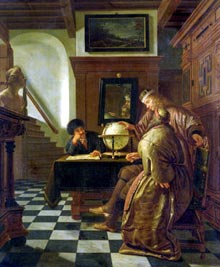
Geographers at Work
Cornelis de Man
c. 1670
81 x 68 cm.
Kunsthalle, Hamburg
The prevalence of women in Dutch interior paintings underscores their significant role within the Dutch household. These unassuming domestic scenes mirror cultural values like family, privacy, intimacy and comfort.
In Dutch paintings where the focus is solely on a male figure, they are typically depicted in their professional roles as doctors, scientists, or painters. Gerrit Dou, one of the highest-paid Dutch painters of the time, portrayed an astronomer charting the stars on a celestial globe, symbolizing the pursuit of knowledge. Cornelis de Man, residing in Delft, created several artworks featuring scholars in their studios, likely influenced by Vermeer's compositions.
Contemporary inspiration

Since their rediscovery, The Astronomer and The Geographer have been considered pendants, two paintings intentionally created to be displayed together. However, some experts, including Blankert, Montias and Aillaud, have raised concerns about certain inconsistencies that challenge their classification as true pendants.
Vermeer authority Walter Liedtke firmly asserts that the two paintings are indeed pendants. Technical analysis supports this claim, revealing that the signatures and dates, identical in both works, are authentic and not later additions as previously speculated. The contemplative nature of the figures in Vermeer's pendants unites them through their intellectual pursuits rather than active engagement. Additionally, both paintings share the same dimensions. Liedtke posits that The Geographer, dated a year later, was intended to hang on the left. Recent research by scientists C. Richard Johnson Jr. and W. A. Sethares further strengthens Liedtke's argument by demonstrating that the canvases for both pictures originate from the same bolt of cloth.
In 1785, the art dealer Alexandre Joseph Paillet imported Vermeer's The Astronomer and The Geographer to Paris. He offered them, along with other paintings, to Count Angevillier, Louis XVI's General Director of Works, for the yet-to-be-completed Luxembourg galleries. Out of the eleven Dutch paintings, the two Vermeers and a work by Pieter de Hooch faced rejection. All three, along with Vermeer's Lady Standing at the Virginal, were put up for sale from the collection of Jan Danser Nymans in Amsterdam in September 1797. At this juncture, The Astronomer and The Geographer were separated and have remained so ever since
The Dutch telescope
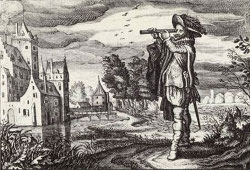
Early depiction of a "Dutch telescope" from the
"Emblemata of zinne-werck" (Middelburg, 1624) of
the poet and statesman Johan de Brune (1588–1658).
The print was engraved by Adriaen van de Venne, who,
together with his brother Jan Pieters van de Venne
printed books not far from the original optical
workshop of Hans Lipperhey.
Vermeer lived in an age and nation where "pure" scientific investigation went hand in hand with the invention and perfection of scientific instrumentation. The Netherlands was, for all practical purposes, a country constantly "under construction."
Cartography was employed for planning battles during the long, brutal war of independence fought against Spain, while engineers provided the necessary mathematical knowledge for the construction of fortifications and assistance in sieges. In times of peace, cartography became indispensable for mapping shipping routes. Mathematics was required to develop efficient land reclamation schemes and defense systems against the sea, which was a constant threat to a nation largely underneath the sea level.
Painters, too, were not averse to utilizing scientific apparatus to understand and replicate complicated optical phenomena they wished to represent on their canvases. Vermeer almost certainly used the camera obscura at some stage in the painting process and at least once, a compass to draw the circular perimeter of a ceramic jug in his early Procuress.
In The Astronomer, Vermeer displays various objects associated with scientific investigation: the celestial globe, a scientific chart and a manual for astronomers by Adriaan Metius, which lies open on the table, as well as an astrolabe. However, he did not intend to portray a real-life astronomer. No telescope, a standard piece of equipment for the average astronomer, can be seen. Furthermore, while not obsolete, the celestial globe and the book by Metius were not the most up-to-date.
In essence, Vermeer shows us an astronomer/philosopher who, as Klass van Berkel wrote, reflects "on the nature of the cosmos, with the help of a book and some instruments; someone who not only calculates and describes but also reflects and contemplates."
Science in Vermeer's time

Measuring the solar altitude with a
mariner's astrolabe. The astrolabe
was the most important astronomical
instrument during the middle ages.
From Adriaan Metius: De genuino usu utrisque
globi tractatus, Franecker, 1624.
Vermeer lived in an age and nation where "pure" scientific investigation went hand in hand with the invention and perfection of scientific instrumentation. The Netherlands was, for all practical purposes, a country constantly "under construction."
Cartography was employed for planning battles during the long, brutal war of independence fought against Spain, while engineers provided the necessary mathematical knowledge for the construction of fortifications and assistance in sieges. In times of peace, cartography became indispensable for mapping shipping routes. Mathematics was required to develop efficient land reclamation schemes and defense systems against the sea, which was a constant threat to a nation largely underneath the sea level.
Painters, too, were not averse to utilizing scientific apparatus to understand and replicate complicated optical phenomena they wished to represent on their canvases. Vermeer almost certainly used the camera obscura at some stage in the painting process and at least once, a compass to draw the circular perimeter of a ceramic jug in his early Procuress.
In The Astronomer, Vermeer displays various objects associated with scientific investigation: the celestial globe, a scientific chart and a manual for astronomers by Adriaan Metius, which lies open on the table, as well as an astrolabe. However, he did not intend to portray a real-life astronomer. No telescope, a standard piece of equipment for the average astronomer, can be seen. Furthermore, while not obsolete, the celestial globe and the book by Metius were not the most up-to-date.
In essence, Vermeer shows us an astronomer/philosopher who, as Klass van Berkel wrote, reflects "on the nature of the cosmos, with the help of a book and some instruments; someone who not only calculates and describes but also reflects and contemplates."
A showcase work for Hitler's museum

The recovery of Vermeer's Astronomer by the Monument Men
Adolf Hitler, himself a failed painter, ordered the pillaging of masterpieces from occupied Europe. One of the works he most coveted was Vermeer's Astronomer.
Hitler wanted The Astronomer, together with The Art of Painting, to be the centerpieces of a museum he planned to build in his hometown, Linz. The Astronomer must have appealed to his nationalistic ambitions since he was convinced that, as well as The Geographer, it celebrated early "Germanic" scientific achievements.
The painting was confiscated, along with more than 5,000 other artworks, from Jewish financier Edouard de Rothschild, whose family had owned it for half a century. It was packed into a crate labeled H13 (H for Hitler), loaded onto a train and shipped from Paris to Germany on February 3, 1941.
The Astronomer was recovered by a cadre of art specialists known as "Monuments Men" in May 1945, along with more than 8,000 other paintings, sculptures and artworks. They were hidden deep in a mountain salt mine in Altaussee, Austria. Alongside it were Michelangelo's Bruges Madonna sculpture, dumped on a filthy mattress, and Jan Van Eyck's Ghent Altarpiece. The mouth of the mine had been dynamited shut, and it was feared that everything had been destroyed in compliance with Hitler's orders to prevent anything falling into the hands of the "conquerors."
Fortunately, Hitler's orders were subverted by two mine engineers who blew up the passages so the Nazis couldn't get past to detonate the rest of the mountain. After the war, The Astronomer was returned to its owner, whose family gave or sold it to the Musée du Louvre in 1983.
The first painting by Vermeer ever to be reproduced
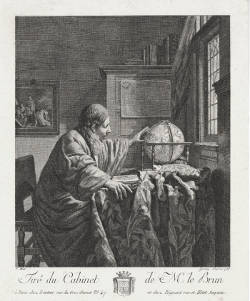
In 1784, the French engraver Louis Garreau, temporarily in Amsterdam, made an engraving of The Astronomer, marking the first time a painting by Vermeer had ever been reproduced. During that period, the painting was the centerpiece of the collection owned by the widow of Jean Etienne Fizeaux, who had acquired it in Amsterdam in 1778. The engraving only appeared in 1792 in a supplement (Recueil de gravures au trait) to the illustrated catalogue of masterpieces published by the art dealer Jean Baptiste Pierre Lebrun, Galerie des peintres flamands, hollandais et allemands (Gallery of Flemish, Dutch and German painters). In this publication, Lebrun made his oft-quoted comment about the neglect of Vermeer by historians. "He is a very great painter, in the fashion of Metsu. His pictures are very rare and are better known and more appreciated in Holland than anywhere else. He was especially fond of rendering the effects of sunlight, and sometimes succeeded to the point of complete illusion." During those years, the French art dealer Alexandre Joseph Paillet and his Dutch colleague Jean Fouquet attempted to offer The Astronomer to the King of France, without success. Despite the King's refusal, Fouquet managed to find a buyer when he returned the painting to Amsterdam, and interest in the work of the Delft master continued to grow.


